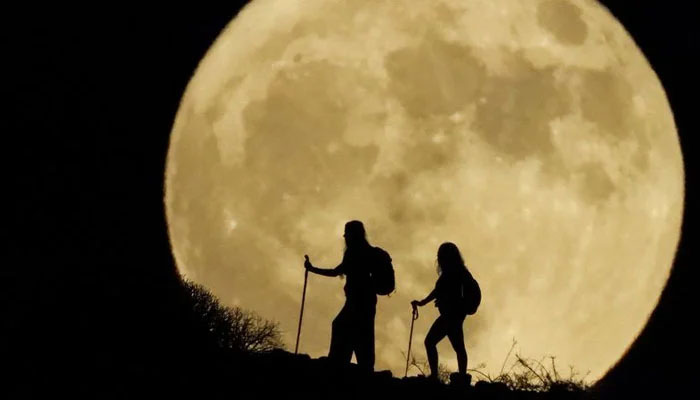Super blue moon to grace sky in Pakistan today
Suparco says next three supermoons will occur on September 18, October 17 and November 15
August 18, 2024

KARACHI: Stargazers who love watching celestial bodies at night are in for a treat as Pakistan will witness the first super blue moon of the year today (Monday), according to the Space and Upper Atmosphere Research Commission (Suparco) on Sunday.
The fascinating sight comes just one year after a Sturgeon moon lit up the skies on August 1 and a super blue moon enthralled the world with its awe-inspiring sight on August 30 last year.
The country's top space agency said that the blue moon would take place in Pakistan today at 11:26pm — the first supermoon to take place this year.
The next three supermoons will occur on September 18, October 17 and November 15, it added.
While sailing in its orbit when the moon comes closest to Earth, i.e. 363,300 kilometres, it shines 30% more brightly and appears 14% bigger. This is when it is called a supermoon.
A supermoon is not an official astronomical term. However, a "supermoon" is a full moon that occurs when the moon's orbit brings it closer to Earth.
What is a Blue Moon?
A Blue Moon is one of the rarest celestial phenomena, being a full moon, blue moon and a super moon. It does not literally mean that the moon will turn blue but it has to do with the frequency of a full moon.
So we know why the term "once in a blue moon" is used as an idiom to describe a rare but nonetheless recurring event.
There are two types of blue moons, both involving the occurrence of full moons multiple times in a month or a calendar season.
While a full moon can occur twice a month, it's a rarity because the cycle of the moon lasts 29.5 days and the average calendar month on Earth is of 30-31 days.
The first type can be described when there are two full moons in a single month.
A full moon recurring in the same month is a rare event as it happens once every two or three years, according to Nasa. The second full moon in a month is called the Blue Moon.
Meanwhile, the second type is the seasonal Blue Moon, in which a calendar season contains four full moons instead of the usual three. The third of the four full moons is called the Blue Moon.
Widely discussed tonight's Blue Moon belongs to this category of phenomena as the next full moon will be the fourth of the season.
Besides all this, tonight's full moon will be a "super blue moon" because the celestial body will be the closest point in its orbit around Earth.
However, not every Blue Moon has to be a supermoon as about 25% of all full moons are supermoons, but only 3% percent of full moons are blue moons.
Nasa describes the supermoon as when a full moon appears within 90% of its closest approach to Earth in its orbit, or its perigee.
At its closest point, the full moon can appear up to 14 percent bigger and 30 percent brighter than the faintest Moon of the year, which occurs when it’s farthest from Earth in its orbit.
The next blue moon is expected to be witnessed in May 2027.









